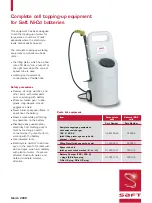
www.lesterelectrical.com 6
35589A
www.fairplayelectriccars.com
TROUBLESHOOTING GUIDE
To be able to troubleshoot safely and effectively,
it is important to read this guide completely
before beginning any tests.
CAUTION: DO NOT DISASSEMBLE THE
CHARGER. TAKE IT TO A QUALIFIED SERVICE
AGENT WHEN SERVICE OR REPAIR IS
REQUIRED. INCORRECT REASSEMBLY MAY
RESULT IN A RISK OF ELECTRIC SHOCK OR
FIRE. THE FOLLOWING PROCEDURES ARE
INTENDED ONLY TO DETERMINE IF A
MALFUNCTION MAY EXIST IN THE CHARGER.
DANGER: TO REDUCE THE RISK OF
ELECTRIC SHOCK, ALWAYS DISCONNECT
BOTH THE POWER SUPPLY CORD AND THE
OUTPUT CORD BEFORE ATTEMPTING ANY
MAINTENANCE OR CLEANING.
WARNING: DO NOT OPERATE THE
CHARGER IF IT IS MALFUNCTIONING.
PERSONAL INJURY OR PROPERTY DAMAGE
COULD RESULT.
To determine if a charger malfunction exists, identify
the problem from the following list and refer to the
appropriate section for detailed instructions.
1. CHARGER DOES NOT TURN ON
2. CHARGER FUSE BLOWS
3. CHARGER DOES NOT TURN OFF
4. THE BUILDING AC LINE CIRCUIT BREAKER
OR FUSE BLOWS
If the problem is other than listed above, refer to a
qualified service agent for additional troubleshooting
procedures.
1. CHARGER DOES NOT TURN ON
The DC plug must be disconnected and reconnected
to start or restart the charger after turn off.
Connect the power supply cord securely to a live AC
outlet. Visually inspect the DC output plug and
battery receptacle to be sure they are in good
working condition.
WARNING: IF THE PLUG OR RECEPTACLE
IS BROKEN, TWISTED, BENT OR LOOSE AND
DOES NOT MAKE GOOD ELECTRICAL
CONTACT, HAVE IT REPLACED BY A
QUALIFIED SERVICE AGENT IMMEDIATELY. DO
NOT USE THIS CHARGER IN THIS CONDITION
AS FIRE OR PERSONAL INJURY CAN RESULT.
If the plug and receptacle are good, connect the DC
plug into the receptacle and listen for the power
relay inside the charger to "click" on within five
seconds. If the "click" is not heard remove the DC
plug from the receptacle and connect the DC plug of
another charger, which you know is operating
properly, to the receptacle.
If still no "click" is heard, a malfunction in the
batteries or receptacle wiring exists. If the "click" is
heard, the batteries and receptacle are good, and a
malfunction exists in the original charger.
If the relay "click" is heard, a hum from the
transformer should be heard and the ammeter
should indicate the charge rate. If no transformer
hum is heard, check to be sure the AC power supply
cord is securely connected to a live AC outlet.
When three-prong to two-prong adapters are used,
they tend to work loose, resulting in a poor
connection. Check the AC line fuse or circuit
breaker and, if possible, connect a functioning
charger, utility light, or other electrical appliance to
the outlet to verify the presence of AC power. If AC
power is present, and still no transformer hum is
heard, the charger is malfunctioning.
If the relay "clicks" and the transformer hums, but no
charge rate is indicated on the ammeter, the charger
is malfunctioning.
2. CHARGER FUSE BLOWS
The charger fuse assembly consists of a fuse wire
with a transparent cover visible on the front of the
charger. The fuse link protects the charger in the
event the SCR or transformer fails.
Check the fuse assembly visually for an open or
blown fuse link. If the fuse assembly blows as soon
as the DC output plug is connected to the battery
receptacle, the charger is malfunctioning.
3. THE CHARGER DOES NOT TURN OFF
New batteries or batteries charged in cold
temperatures may require an extended charge time
to achieve full charge. The charger implements a 20
hour maximum timer to protect the system. If the
charger runs for more than 20 hours without shutting
off, the charger is malfunctioning.
4. THE BUILDING AC LINE CIRCUIT BREAKER
OR FUSE BLOWS
This condition can be caused by a charger problem,
a "weak" fuse or circuit breaker protecting the circuit,
or an overloaded circuit. If the building AC power
fuse or circuit breaker blows, connect the charger to
other outlets (on different circuits) in the building. If
the charger operates properly on other circuits, have
a qualified electrician inspect and test the original
circuit. If the charger causes other fuses or circuit
breakers (in the building) to blow, the charger should
be tested for a problem.


























